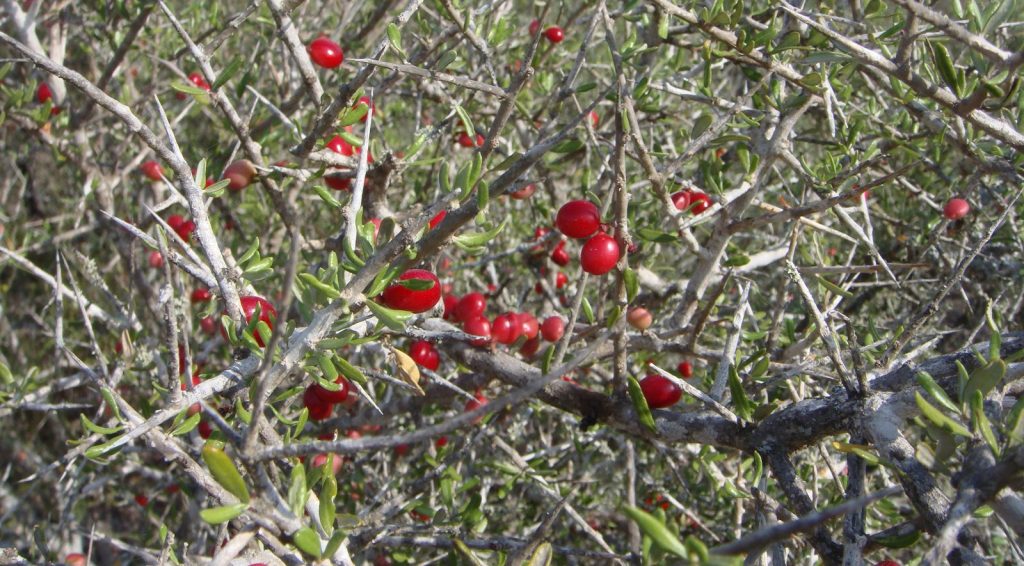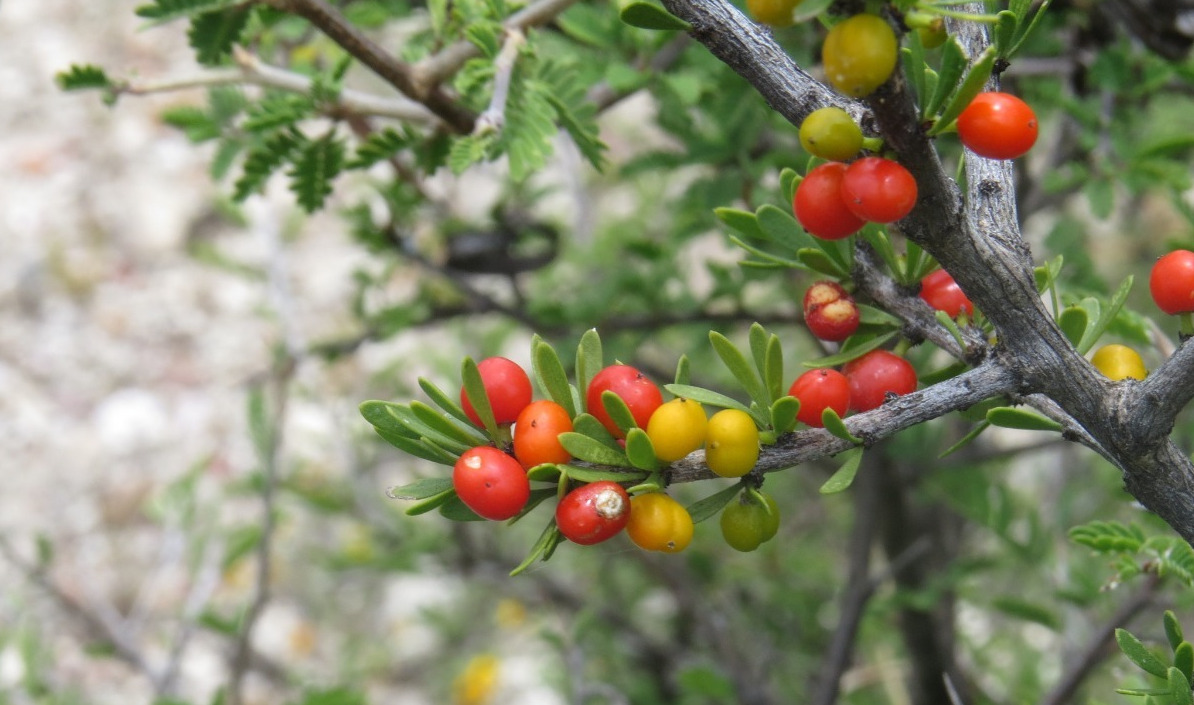Scientific Name: Castela tortuosa
Other Names: Chaparro Amargoso, Chaparro Amargo, Amargoso, Bitter Chaparro, Coma de Arboles, Guayacan, Espino Blanco, White Thorn, Chaparral
Family: Simaroubaceae
Habitat: Castela tortuosa is a small tree that grows in the Sonoran and Chihuahuan deserts of Mexico and the southwestern United States. It prefers well-drained soils in arid and semi-arid regions.
Brief Description
Castela tortuosa is a small tree that reaches a height of 5 to 10 feet. It has twisted, spiny branches with small, oval-shaped, green leaves. The flowers are small and yellow, and the fruit is a dry, woody capsule that contains seeds.
Actions
The bark and leaves of Castela tortuosa have been traditionally used for their antiseptic, anti-inflammatory, analgesic, antipyretic, and diuretic properties.
Traditional Uses
In traditional medicine, Castela tortuosa has been used for a variety of conditions, including arthritis, fever, diarrhea, dysentery, stomach ulcers, skin conditions, and respiratory infections.
Principal Uses: Castela tortuosa is mainly used for its antiseptic and anti-inflammatory properties. It has been traditionally used topically for skin conditions such as eczema, psoriasis, and acne. It has also been used internally for conditions such as arthritis, fever, and respiratory infections.
Other Uses: Castela tortuosa has been used as a natural insecticide and as a treatment for snake bites.
How is Chaparro Amargo used in different countries?
Chaparro Amargo, also known as Castela tortuosa, is used in different ways in different countries. Here are some examples:
Mexico: In Mexico, Chaparro Amargo is a popular herbal remedy for a variety of ailments. It is often brewed into a tea and consumed to treat conditions such as respiratory infections, fever, and digestive issues.
United States: In the southwestern United States, Chaparro Amargo has been traditionally used by Native American tribes for its medicinal properties. It is used to treat skin conditions, fever, and arthritis.
Brazil: In Brazil, Chaparro Amargo is used as a natural insecticide to repel mosquitoes and other insects.
Peru: In Peru, Chaparro Amargo is used to treat digestive issues, such as stomach ulcers and diarrhea. It is also used as a natural remedy for respiratory infections.
Argentina: In Argentina, Chaparro Amargo is used as a natural remedy for skin conditions such as eczema and psoriasis.
Overall, Chaparro Amargo is used in various ways across different countries and cultures. It is a versatile herb that has been used for centuries for its medicinal properties.
Medicinal Parts
The bark and leaves are used for medicinal purposes.
Preparation and Dosage
The bark and leaves of Castela tortuosa can be prepared as a tea, tincture, or poultice. The dosage and preparation method may vary depending on the condition being treated.
Herbal formulas: Castela tortuosa is often used in combination with other herbs in traditional medicine formulas.
Chaparro Amargo herbal recipes
Here are a few herbal recipes that use Chaparro Amargo:
Chaparro Amargo Tea: To make Chaparro Amargo tea, steep 1-2 teaspoons of dried Chaparro Amargo bark or leaves in a cup of hot water for 10-15 minutes. Strain and drink 1-3 times a day.
Chaparro Amargo Tincture: To make a Chaparro Amargo tincture, combine 1 part dried Chaparro Amargo bark or leaves with 5 parts of 80-proof alcohol (such as vodka). Allow the mixture to sit for 4-6 weeks, shaking daily. Strain and store the tincture in a dark glass bottle. Take 30-60 drops in water, 1-3 times a day.
Chaparro Amargo Salve: To make a Chaparro Amargo salve, melt 1/4 cup of beeswax and 1/2 cup of coconut oil in a double boiler. Add 1/4 cup of dried Chaparro Amargo bark or leaves and continue heating until the mixture is well combined. Pour the mixture into a jar and allow it to cool and solidify. Apply the salve to affected areas of the skin as needed.
Scientific Research
Studies have shown that the bark of Castela tortuosa contains compounds with antimicrobial and anti-inflammatory properties. Other studies have shown that Castela tortuosa extracts have analgesic and antipyretic effects. However, further research is needed to fully understand the potential therapeutic uses of Castela tortuosa.
Cautions
Castela tortuosa should not be used during pregnancy or breastfeeding. It may cause allergic reactions in some individuals.
Side-effects and Contraindications
Castela tortuosa may cause gastrointestinal discomfort in some individuals. It may also interact with certain medications, including blood thinners and diabetes medications.

References
Herrera-Ruiz M, et al. Anti-inflammatory and analgesic activities from roots of Castela texana and C. tortuosa. J Ethnopharmacol. 2012;143(1):292-297.
Reyes-Chilpa R, et al. Antibacterial activity of extracts from Castela tortuosa (Simaroubaceae). J Ethnopharmacol. 2005;96(1-2):177-181.
Barajas-Farias LM, et al. Antidiarrheal activity of Castela tortuosa (Simaroubaceae) and its effect on intestinal motility in rats. J Ethnopharmacol. 2012;141(2):807-811.
This article is copyrighted by Ital is Vital, 2025. Want to re-post this article? Visit our guidelines.
DISCLAIMER: THIS WEBSITE DOES NOT PROVIDE MEDICAL ADVICE
The information, including but not limited to, text, graphics, images and other material contained on this website are for informational purposes only. The purpose of this website is to promote broad consumer understanding and knowledge of various health topics. It is not intended to be a substitute for professional medical advice, diagnosis or treatment. Always seek the advice of your physician or other qualified health care provider with any questions you may have regarding a medical condition or treatment and before undertaking a new health care regimen, and never disregard professional medical advice or delay in seeking it because of something you have read on this website.
